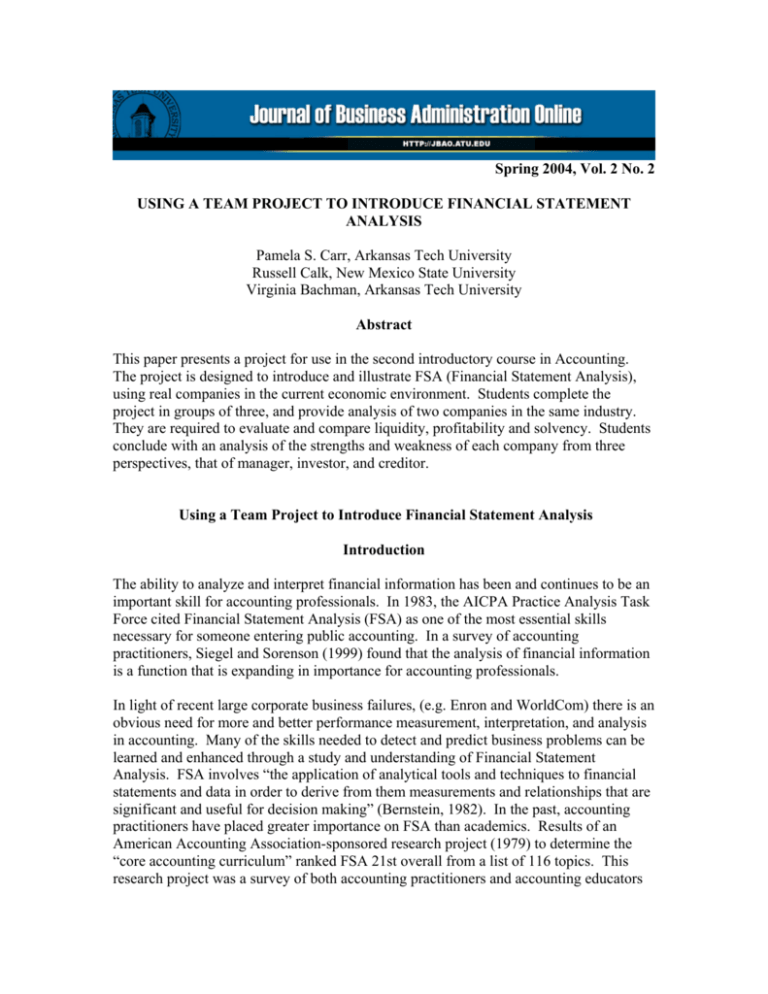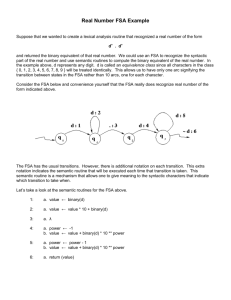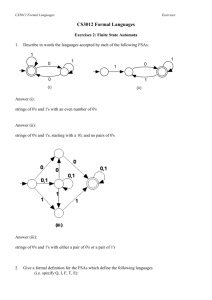financial statement analysis
advertisement

Spring 2004, Vol. 2 No. 2 USING A TEAM PROJECT TO INTRODUCE FINANCIAL STATEMENT ANALYSIS Pamela S. Carr, Arkansas Tech University Russell Calk, New Mexico State University Virginia Bachman, Arkansas Tech University Abstract This paper presents a project for use in the second introductory course in Accounting. The project is designed to introduce and illustrate FSA (Financial Statement Analysis), using real companies in the current economic environment. Students complete the project in groups of three, and provide analysis of two companies in the same industry. They are required to evaluate and compare liquidity, profitability and solvency. Students conclude with an analysis of the strengths and weakness of each company from three perspectives, that of manager, investor, and creditor. Using a Team Project to Introduce Financial Statement Analysis Introduction The ability to analyze and interpret financial information has been and continues to be an important skill for accounting professionals. In 1983, the AICPA Practice Analysis Task Force cited Financial Statement Analysis (FSA) as one of the most essential skills necessary for someone entering public accounting. In a survey of accounting practitioners, Siegel and Sorenson (1999) found that the analysis of financial information is a function that is expanding in importance for accounting professionals. In light of recent large corporate business failures, (e.g. Enron and WorldCom) there is an obvious need for more and better performance measurement, interpretation, and analysis in accounting. Many of the skills needed to detect and predict business problems can be learned and enhanced through a study and understanding of Financial Statement Analysis. FSA involves “the application of analytical tools and techniques to financial statements and data in order to derive from them measurements and relationships that are significant and useful for decision making” (Bernstein, 1982). In the past, accounting practitioners have placed greater importance on FSA than academics. Results of an American Accounting Association-sponsored research project (1979) to determine the “core accounting curriculum” ranked FSA 21st overall from a list of 116 topics. This research project was a survey of both accounting practitioners and accounting educators requesting their ranking of the relative importance of various accounting topics to ascertain those which were considered to be essential in the education of accounting students seeking a Bachelors degree in Accounting. Practitioners ranked FSA 20th in importance while academics ranked it 40th. While the study and process of FSA is broad enough to fill up an entire college level course, many schools try to integrate FSA coverage into other accounting or finance courses. Prober and Sherman (1988) report that only seventeen percent, of the 219 AACSB accredited schools surveyed, offered a separate course in FSA. In that same study more than half reported FSA was covered in an introductory accounting class. This undergraduate level of study seems to be an appropriate place to use the tools of FSA and for students to learn to interpret the results of their research. After coming to an understanding of the income statement, balance sheet, and statement of cash flows, students can begin to perform simple manipulations such as common sized and comparative statements and simple trend analysis. Brown (1998) suggests that the most useful tools for assessing profitability and risk are financial statement ratios. These ratios express relationships between elements of the balance sheet, income statement and statement of cash flows signaling performance levels for a company. Comparisons of these ratios with industry averages are useful in determining the direction the company may be going. Most introductory accounting texts offer a chapter on FSA with explanations of these simple tools. Academics need to go further and reinforce these tools with a comprehensive understanding of what the results of these analyses mean. Fsa Team Project An excellent way to teach the methodology of FSA and an understanding of the results is to use a comparison of two or more real-world companies in the same industries. It is important to use at least two years data for each company so that comparisons can be made within years as well as between entities. Industry averages may also be used to place the companies as players in the market place. The FSA project is a collaborative effort of the team members and consists of a report from 6-10 pages, following the directions in EXIBIT I. Students essentially tell the financial “stories” of the two companies chosen, evaluating the past success and projecting likely success in the future. Financial information is readily available via the internet or a computer database through the library. Use of these sources also expands the students’ knowledge of where and how to find financial information for the future. A good way to start the project is with research into the company itself: its origin, products, geographic market area and history of stock prices. Another factor to examine is the industry and its outlook. Teams can be chosen by the students or the instructor, but groups of 3 (no more than 4), seem to work best. Students should be encouraged to express their findings with graphs or charts or any other helpful illustrations. The project could also be the basis for class presentations with various media contributions. Grading of the project is made simple if the teams are allowed to choose between a few companies where the instructor has already obtained and calculated the necessary information. EXIBIT II provides a grading sheet enumerating all of the requirements of the project so that it is easy to account for them in the project. Because the project works well as a team effort, the instructor may also want to include team members’ comments about each member’s work in the grading. Conclusions Koehn and Hallam (1999) suggest that the benefits of incorporating FSA into the curriculum warrant the extra efforts. They point out that FSA builds analytical skills in students. It develops the ability to reinforce and synthesize knowledge gained in earlier courses, and provides a natural forum for students to improve their oral presentation and analytical writing skills. Other benefits perceived by the students reveal that they believe the project helped apply the tools they had learned and the experience provided by the project made them feel more comfortable about doing FSA in the future. The project made them aware of the amount of financial information provided on the internet. Most students enjoy and gain interpersonal skills from working in groups. Team projects such as the one suggested here offer an interesting, helpful way of integrating FSA into the second introductory accounting course. References AAA Committee on the Future Structure, Content & Scope of Accounting Education (1986) Future Accounting Education: Preparing for the Expanding Profession. Sarasota, FL: AAA. AICPA (1983) Report of the AICPA Practice Analysis Task Force. New York: AICPA. Bernstein, L. (1982).Financial Statement Analysis: Theory Application, and Interpretation, 3rd Ed. Homewood, IL: Richard D. Irwin. Brown, Paul R. (1998). A Model For Effective Financial Analysis. Journal of Financial Statement Analysis (Summer): 60-63 Koehn, J.L. and J. J. Hallam, (1999). A Course Survey of Financial Statement Analysis. Journal of Accounting Education (Fall): 413-421. Needles, Powers, Mills & Anderson (1999). Principles of Accounting, 7th Ed. Houghton Mifflin Co. 269-270 Prober. L. M., and W. R. Sherman (1988). Financial statement analysis in the undergraduate accounting curriculum. Journal of Accounting Education (Fall): 106-118 Siegel and Sorenson (1999). Counting More, Counting Less: Transformations in the Management Accounting Profession. A Research Project of the Institute of Management Accountants. Exhibit I Financial Statement Analysis Project 1. You will use two companies in the same industry and obtain their annual reports. (You may get information about these companies only from the internet or a computer database through the library) Describe the principal product or service that each company provides, its main geographic area of activity, and the ending date of its last fiscal year. 2. Find at least two articles, again using the internet, that discuss the current situation in this industry or that present information about your companies .Summarize the main points of these articles. Describe the industry and its outlook and summarize the company’s future plans based on your research and on reading the annual report. 3. Look up both companies’ stock price and record them each day for a week. On what stock exchange are the stocks traded? What are their ticker symbols? 4. Prepare a horizontal analysis of each company using their balance sheets for the last two years. Prepare a vertical analysis (common-sized) of each company using their income statements. Make comparisons between the two companies. 5. Prepare a comparison of the following ratios for the two companies: 1- Working capital 2- Current ratio 3- Receivable turnover 4- Average days’ sales uncollected 5- Inventory turnover 6- Average day’s inventory on hand 7- Profit margin 8- Asset turnover 9- Return on Assets 10- Return on Equity 11- Debt to equity 12- Price/earnings per share 6. Examine the Statements of Cash Flows for Both Companies 1- Are cash flows from operations more or less than income for the past two years? 2- Are the companies expanding through investing activities? 3- What are the companies’ most important sources of financing? 4- Overall, has cash increased or decreased over the past two years? 7. Prepare three paragraphs giving your conclusions about these two companies. Each team member will act as a different financial statement user. One team member should evaluate the companies based on the investor’s point of view, one from the creditor’s point of view, and one from the manager’s point of view. (The entire project should be from 6 to 10 pages in length.) (You may use graphs or charts showing the results of your comparisons) You may choose from the following: Group 1Industry - Department Stores Group 2 Industry - Department Stores Nordstrom, Inc. J. C. Penney The May Company Dillards (Adapted from Needles, Powers, Mills & Anderson’s Principles of Accounting, (1999) Houghton Mifflin, p269-270.) Exhibit Ii Financial Statement Analysis Project--Grading Sheet _____ Describe the principal product or service that each company provides _____ Describe its main geographic area of activity _____ Give the ending date of its last fiscal year. _____ Summary of two internet articles discussing the current situation in this industry or presenting information about your companies. _____ Describe the industry and its outlook and summarize the company’s future plans based on your research and on reading the annual report. _____ Look up both companies’ stock price and record them each day for a week. On what stock exchange are the stocks traded? What are their ticker symbols? _____ Prepare a horizontal analysis of each company using their balance sheets for the last two years. _____ Prepare a vertical analysis (common-sized) of each company using their income statements. Make comparisons between the two companies. Comparison of the ratios for the two companies: _____ Working capital _____ Current ratio _____ Receivable turnover _____ Average days’ sales uncollected _____ Inventory turnover _____ Average day’s inventory on hand _____ Profit margin _____ Asset turnover _____ Return on Assets _____ Return on Equity _____ Debt to equity _____ Price/earnings per share Examination of the Statements of Cash Flows for Both Companies: _____ Are cash flows from operations more or less than income for the past two years? _____ Are the companies expanding through investing activities? _____ What are the companies’ most important source of financing? _____ Overall, has cash increased or decreased over the past two years? _____ Prepare three brief paragraphs giving your conclusions about these two companies, which you think would be the better investment and why. (Investor____) (Creditor____) (Manager_____)






